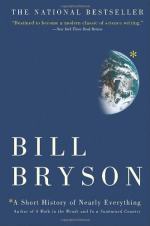
|
Part 1, Chapter 1
• Most cosmologists believe that the Big Bang occurred about 13.7 billion years ago.
• The Big Bang Theory first came up in the 1920s, but it did not catch on until 1965.
• When American astronomers, Arno Penzias and Robert Wilson, experimented with a large Bell Labs communication antenna, they did not realize that the distracting background noise they were trying to eliminate was remnant radiation from the Big Bang.
• Nobody knows what caused the Big Bang, but scientists have proposed a number of theories, including that it could have resulted from an earlier universe collapsing.
• If our universe had formed just slightly differently, our planet would most likely not have taken shape and mankind would not exist.
Part 1, Chapter 2
• Pluto's large moon was not discovered until 1978; it was spotted by James Christy in Flagstaff, Arizona.
• The icy dwarf planet Pluto was discovered in 1930, and some scientists believe that a...
|
This section contains 3,285 words (approx. 11 pages at 300 words per page) |

|




